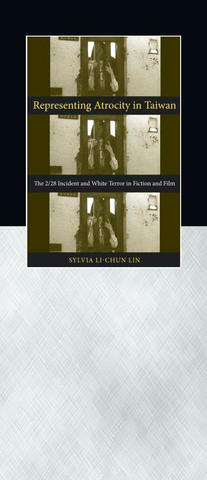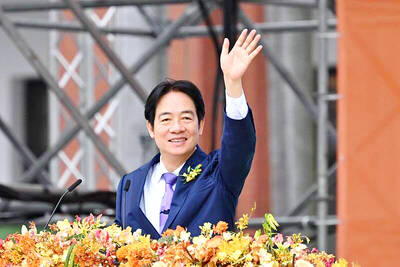The publishers of this new book state in their accompanying promotional material "This is the first book to be published in English on the 2/28 Incident and White Terror." If true, it's an astonishing state of affairs. And Representing Atrocity in Taiwan itself isn't an account of those events either, but rather a consideration of how they were subsequently treated (when they were treated at all) by Taiwan's writers and filmmakers. This means the publishers are tacitly claiming there is still no English-language account at all of those terrible years.
Can this really be the case? There is George H. Kerr's Formosa Betrayed, though it's largely a personal memoir. And a look through Sylvia Li-chun Lin's bibliography here uncovers another title that appears to fit the bill: A Tragic Beginning: The Taiwan Uprising of February 28, 1947 by Tse-han Lai (賴澤涵), Raymond H. Meyers and Wei Wou (魏萼) (Stanford University Press, 1991). There's certainly some English material online, including Formosa Betrayed complete, even though the continuing unavailability of crucial documents is frequently lamented.
It's easy to understand why a full account of the years 1947 to 1987 is difficult. With any discussion of the 2/28 massacre forbidden, as it was prior to 1987, and any discussion of the disappearances and executions that followed it very dangerous, there must be a shortage of factual material. On the other hand Taiwan now enjoys what this author calls "unprecedented civil liberties that guarantee the freedoms of speech, press and congregation." And the world - which often in reality means the English-speaking world - surely needs as complete an account as possible of atrocities Lin compares in brutality to the Holocaust, the bombing of Hiroshima and Nagasaki, and the regime of Pol Pot.

Much of this book, though, is concerned with the contradictions that accompany the straightforward depiction of any historical event. Lin deals in depth with the widespread criticism of Hou Hsiao-hsien's (侯孝賢) film A City of Sadness (悲情城市) that erupted when it was released in 1989. This focused on the absence of any depiction of the central events of 2/28, as well as on the fact that the film showed local Taiwanese attacking Chinese of mainland extraction without any parallel portrayal of the much more serious assaults by the Chinese Nationalist Party (KMT) military on the local population that prompted such reactions.
Lin argues that individuals remember different things and have separate viewpoints, and so there is no one "true" picture. Artists, too, tend to avoid producing anything that might look like propaganda, as any work showing the evils of 2/28 and the White Terror directly might appear to be. But this hasn't prevented writers and directors elsewhere from creating far more explicit historical depictions than have apparently appeared to date in Taiwan.
Lin argues books and films touching on these years allowed their audiences "to confront the fact that no historical experience can ever be completely recaptured on screen (or in writing)." This seems a rather sophisticated point for people who lost family members through state brutality to take on board. What ordinary people consider as "the truth" is something more basic and simple than this.
It's widely felt, for example, that Solzhenitsyn depicted such simple truth in books like The First Circle and One Day in the Life of Ivan Denisovich, that Tolstoy unambiguously showed the callousness of the 19th-century Russians in Chechnya in Hadji Murad, and that Orwell's Animal Farm offered an appropriate fable for what happened in the former Soviet Union under communism. Films such as Eisenstein's Battleship Potemkin and October displayed the Russian Revolution with little regard for dissenting viewpoints, and The Killing Fields showed the agony of Cambodia in the 1970s very directly.
Despite Lin's sympathetic analyses of what Taiwan's artists have managed to come up with, it can still be argued that something far more hard-hitting, and of epic stature, in literature and film, is both possible and desirable.
Sylvia Lin also points to women as popular images of suffering, even though, as she says, most of Taiwan's political victims were men, and looks at the issue of ethnicity in representations of Taiwan's history. Lin is, incidentally, a Taiwanese translator and scholar working in the US at the University of Notre Dame, Illinois, and is married to perhaps the most illustrious translator from Chinese into English that we have, Howard Goldblatt.
So - still no full account in English of Taiwan's years of state terror, and still no Taiwanese novels or films that depict the period's horrors head-on? This would appear to be the fundamental situation, only partially revealed by this nonetheless scrupulous and carefully argued book.
Possibly the reality is that modern Taiwan is simply too proud of its recent achievements to want to look back. The one-party state wasn't without its supporters, after all. "Most Taiwanese citizens," Lin writes of that earlier period, "accepted the government's position that these dissidents were in fact threatening national security and should be severely punished. The democratic ideal that a nation's citizens should be free to voice dissenting views without fear of persecution was completely alien to the majority of the Taiwanese, who deemed the fight for such rights as being seditious."
Despite such fighting talk, Representing Atrocity in Taiwan isn't the rallying cry this state of affairs ideally calls for. Instead, it looks scrupulously and honestly at the artistic results of the situation. So what is still needed is some young Taiwanese writer, some modern Emile Zola untouched by the academic proprieties, to bewail from the rooftops the continuing lack of a full account of such a hideously cruel, and indeed horrific, past, pointing the finger of accusation where he or she will.

May 18 to May 24 Pastor Yang Hsu’s (楊煦) congregation was shocked upon seeing the land he chose to build his orphanage. It was surrounded by mountains on three sides, and the only way to access it was to cross a river by foot. The soil was poor due to runoff, and large rocks strewn across the plot prevented much from growing. In addition, there was no running water or electricity. But it was all Yang could afford. He and his Indigenous Atayal wife Lin Feng-ying (林鳳英) had already been caring for 24 orphans in their home, and they were in

President William Lai (賴清德) yesterday delivered an address marking the first anniversary of his presidency. In the speech, Lai affirmed Taiwan’s global role in technology, trade and security. He announced economic and national security initiatives, and emphasized democratic values and cross-party cooperation. The following is the full text of his speech: Yesterday, outside of Beida Elementary School in New Taipei City’s Sanxia District (三峽), there was a major traffic accident that, sadly, claimed several lives and resulted in multiple injuries. The Executive Yuan immediately formed a task force, and last night I personally visited the victims in hospital. Central government agencies and the

Australia’s ABC last week published a piece on the recall campaign. The article emphasized the divisions in Taiwanese society and blamed the recall for worsening them. It quotes a supporter of the Taiwan People’s Party (TPP) as saying “I’m 43 years old, born and raised here, and I’ve never seen the country this divided in my entire life.” Apparently, as an adult, she slept through the post-election violence in 2000 and 2004 by the Chinese Nationalist Party (KMT), the veiled coup threats by the military when Chen Shui-bian (陳水扁) became president, the 2006 Red Shirt protests against him ginned up by

As with most of northern Thailand’s Chinese Nationalist Party (KMT) settlements, the village of Arunothai was only given a Thai name once the Thai government began in the 1970s to assert control over the border region and initiate a decades-long process of political integration. The village’s original name, bestowed by its Yunnanese founders when they first settled the valley in the late 1960s, was a Chinese name, Dagudi (大谷地), which literally translates as “a place for threshing rice.” At that time, these village founders did not know how permanent their settlement would be. Most of Arunothai’s first generation were soldiers